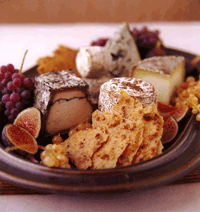 |
|||||
|
|
|
|
|
|
|
Hazelnut Wafers with Cheese and Fruitfrom the Wine Lover's Dessert Cookbook by Mary Cech & Jennie Schacht |
|

Ingredients:
1/3 cup hazelnuts, toasted and skinned
|
Sweet wines at once contrast and complement the earthy, nutty, and salty flavors found in fine cheeses, especially when served with these nutty, delicately sweetened wafers. Fresh or dried dates, figs, apricots, or grapes make a lovely addition. Our gratitude goes to Laura Werlin, food writer and cheese expert, for suggesting many of the cheeses below.
Preheat the oven to 325 degrees F and position a rack near the center. Line a 17-by-12-inch baking sheet with a silicone baking sheet Pulse the nuts with the sugar in a food processor until they are the texture of coarse cornmeal with some slightly larger pieces. Transfer the nuts to a medium bowl and stir in the flour and salt. Whisk in the egg whites until well blended. Using an offset spatula, spread the batter thinly and evenly on the silicone mat, covering about two-thirds of the mat's surface. For the crispiest wafers, you should almost be able to see through the batter, and for even browning, avoid thinning it along the edges. Don't be concerned if the nuts poke small holes in the wafer. Bake until the wafer is brown all over, 12 to 15 minutes. Check frequently toward the end, as the wafer can darken and burn quickly. Invert the pan over a clean, flat surface and remove the pan. Wait 1 minute before carefully peeling the baking mat from the wafer. When it is completely cool, break the wafer into odd-size serving pieces. Store the wafers in an airtight container at room temperature away from moisture, which will soften them. Arrange the cheeses on a serving platter and surround with the fruit and hazelnut wafers. Alternatively, serve small portions of the cheeses on individual plates with just one or two pieces of fruit and a smaller piece of the wafer, offer additional wafers on the side. Makes 6 servings Selecting Cheese. It can be fun to offer three very different styles on a cheese plate, allowing guests to experience how each alters the experience of the wine and vice versa. One way is to include a goat's, a cow's, and a sheep's milk cheese. Another is to include a soft, rich cheese; a firmer cheese; and a blue cheese. Below are a few of our favorites for pairing with sweet wines. If there is a good cheese shop in your area, tell them about your wine selections and ask for their suggestions. Laura Werlin recommends full-flavored, aged cheeses for pairing with sweet wines. Consider a manchego from Spain, an aged goat cheese or gouda (cow or goat), or a Dry Jack from Vella Cheese Company in Sonoma, California, a nutty, almost sweet take on aged Monterey Jack with a rind rubbed dark with black pepper and cocoa. Roth Käse in Wisconsin makes a cow's milk Gruyère that is heat-treated but not pasteurized, preserving the milk's subtle flavors. Washed rind cheeses often have well developed flavors. Consider a French Reblochon or Epoisses, a rich Italian Taleggio, or an Alsatian Muenster. Ossau-Iraty is a ewe's milk cheese with a firm but creamy texture and nutty flavor. This cheese is made in the western Pyrenees, in Basque country, handcrafted by shepherds. In its home area, the cheese goes by the nickname, "farmer's dessert." Or try California-based Bellwether Farms' San Andreas, a mild, smooth sheep's milk cheese named for the earthquake fault that runs through the family's property. Fermier cheeses are made in very small batches using only milk from the cheesemaker's own herd. Lingot de Quercy, one of only a few fermier cheeses available in the United States, is a goat's milk cheese from the French Pyrenees. It is visually striking, with a rind that falls in folds around a runny outer layer encasing a creamy white center. Crottin de Chavignol is a good choice from the Loire Valley. Banon is an attractive goat cheese (often with small amounts of cow's and sheep's milk) that offers rich flavor and smooth texture when ripe. The northern Provençal cheese comes in small wheels washed in eau-de-vie, cured in chestnut or grape leaves, and tied with raffia, Capriole Farms in Indiana makes an American Banon. Cypress Grove's Humboldt Fog from Northern California is another delicious and beautiful choice; a mildly goaty cheese that intensifies with age, each wedge is accented by a line of edible, dark vegetable ash that recalls the area's morning fog. Just about any style of blue cheese pairs well with sweet wines. Valdeon, a blue cheese from Spain, is rich and somewhat nutty with abundant blue veins. Cabrales is an intense Spanish blue that may be more widely available. A wonderfully rich and creamy blue for ending a meal is Saint Agur, a cow's milk cheese from Auvergne boasting 60 percent fat. We also love Cashel Blue from Ireland, and Point Reyes Farmstead Cheese Company's Original Blue from California, a rich, tangy blue made with raw milk from Holstein cows. |
|
Copyright © 2005 Epicurean.com & Chronicle Books All rights reserved |
|
|